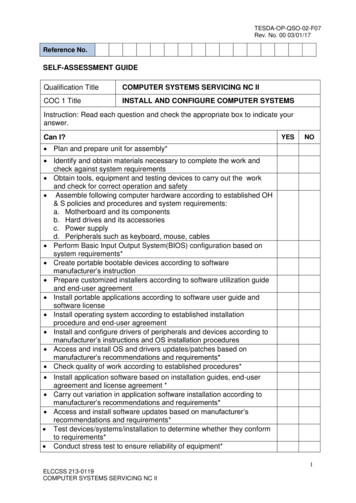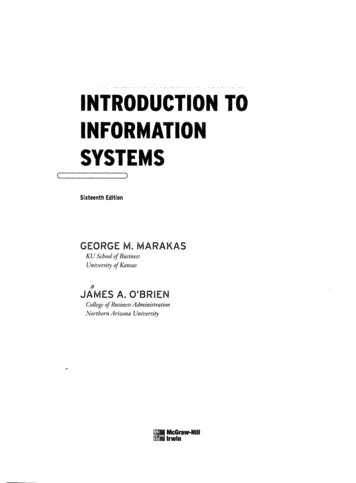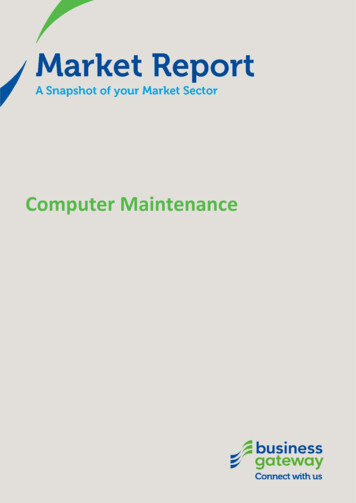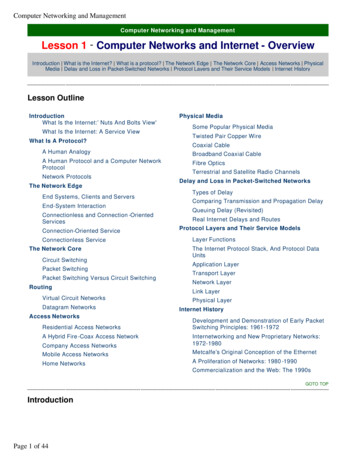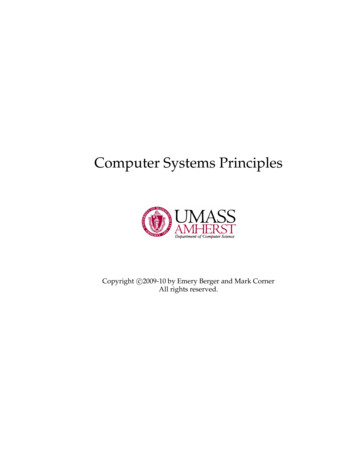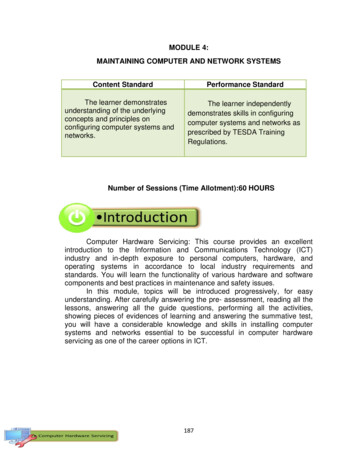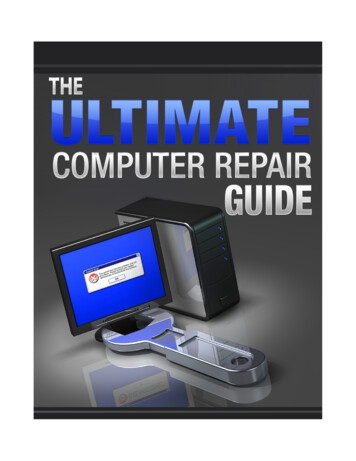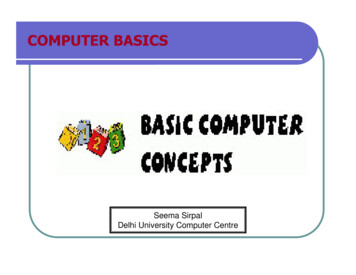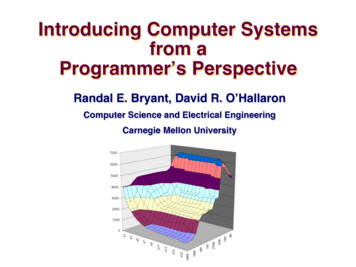
Transcription
Introducing Computer Systemsfrom aProgrammer’s Perspective"Randal E. Bryant, David R. O’Hallaron"Computer Science and Electrical Engineering"Carnegie Mellon University"
Outline"Introduction to Computer Systems"n n Course taught at CMU since Fall, 1998"Some ideas on labs, motivations, "Computer Systems: A Programmer’s Perspective"– 2 –!n Our textbook, now in its second edition"n Ways to use the book in different courses"ICS!
Background"1995-1997: REB/DROH teaching computerarchitecture course at CMU."n n Good material, dedicated teachers, but students hate it"Don’t see how it will affect their lives as programmers"Course Evaluations54.5CS Average43.5REB: Computer Architecture32.521995– 3 –!1996199719981999200020012002ICS!
Computer ArithmeticBuilder’s Perspective!32-bit"Multiplier"n – 4 –!How to design high performance arithmetic circuits"ICS!
Computer ArithmeticProgrammer’s Perspective!void show squares(){int x;for (x 5; x 5000000; x* 10)printf("x %d x 2 %d\n", x, x*x);}xxxxxxxn n 5 50 500 5000 50000 500000 5000000x2x2x2x2x2x2x2 6Numbers are represented using a finite word size"Operations can overflow when values too large"l But behavior still has clear, mathematical properties"– 5 –!ICS!
Memory SystemBuilder’s Perspective!Builder’s Perspective""Directmapped orsetindexed?"Writethrough orwrite back?"""Regs!"CPU!L1 d-cache!L1 i-cache!L2 emory!Disk!""How manylines?"Virtual orphysicalindexing?""– 6 –!n Must make many difficult design decisions"n Complex tradeoffs and interactions between components"ICS!
Memory SystemProgrammer’s Perspective!void copyij(intint{int i,j;for (i 0; ifor (j 0;dst[i][j]}5.2 ms"src[2048][2048],dst[2048][2048]) 2048; i )j 2048; j ) src[i][j];void copyji(intint{int i,j;for (j 0; jfor (i 0;dst[i][j]}n 2048; j )i 2048; i ) src[i][j];162 ms"30 times slower!"n src[2048][2048],dst[2048][2048])(Measured on 2.7 GHz"Intel Core i7)"Hierarchical memory organization"Performance depends on access patterns"l Including how step through multi-dimensional array"– 7 –!ICS!
The Memory Mountain"– 8 –!Core i7!2.67 GHz!32 KB L1 d-cache!256 KB L2 cache!8 MB L3 cache!ICS!
Background (Cont.)"1997: OS instructors complain about lack ofpreparation"n Students don’t know machine-level programming wellenough"l What does it mean to store the processor state on the run-time stack?"n – 9 –!Our architecture course was not part of prerequisitestream"ICS!
Birth of ICS"1997: REB/DROH pursue new idea:"n n Introduce them to computer systems from a programmer'sperspective rather than a system designer's perspective."Topic Filter: What parts of a computer system affect thecorrectness, performance, and utility of my C programs?"1998: Replace architecture course with new course: "n 15-213: Introduction to Computer Systems"Curriculum Changes"n n Sophomore level course"Eliminated digital design & architecture as requiredcourses for CS majors""– 10 –!ICS!
15-213: Intro to Computer Systems"Goals"n n Teach students to be sophisticated application programmers"Prepare students for upper-level systems courses"Taught every semester to 400 studentsn n n n ""All CS undergrads (core course)"All ECE undergrads (core course)"Many masters students"l To prepare them for upper-level systems courses"Variety of others from math, physics, statistics, "Preparation"n n – 11 –!Optional: Introduction to CS in Python or Ruby"Imperative programming in C subset"ICS!
ICS Feedback"Students""Course Evaluations"5"REB: Intro. Comp. Systems4.5CS Average4"3.5"REB: Computer 2"Faculty"n n – 12 –!Prerequisite for most upper level CS systems courses"Also required for ECE embedded systems, architecture, andnetwork courses"ICS!
Lecture Coverage ""Data representations [3]"n n It’s all just bits.int’s are not integers and float’s are not reals."IA32 & x86-64 machine language [5]"n Analyzing and understanding compiler-generated machinecode."Program optimization [2]"n Understanding compilers and modern processors."Memory Hierarchy [3]"n Caches matter!"Linking [1]"n – 13 –!With DLL’s, linking is cool again!"ICS!
Lecture Coverage (cont)"Exceptional Control Flow [2]"n The system includes an operating system that you mustinteract with."Virtual memory [4]"n How it works, how to use it, and how to manage it."Application level concurrency [3]"n n Processes and threads"Races, synchronization"I/O and network programming [4]"n Programs often need to talk to other programs."Total: 27 lectures, 14 week semester"– 14 –!ICS!
Labs"Key teaching insight: "n Cool Labs Great Course""A set of 1 and 2 week labs define the course.""Guiding principles:"n n n n – 15 –!Be hands on, practical, and fun."Be interactive, with continuous feedback from automaticgraders"Find ways to challenge the best while providing worthwhileexperience for the rest"Use healthy competition to maintain high energy."ICS!
Lab Exercises"Data Lab (2 weeks)"n Manipulating bits."Bomb Lab (2 weeks) "n Defusing a binary bomb."Buffer Lab (1 week) "n Exploiting a buffer overflow bug."Performance Lab (2 weeks)"n Optimizing kernel functions."Shell Lab (1 week) "n Writing your own shell with job control."Malloc Lab (2-3 weeks) "n Writing your own malloc package."Proxy Lab (2 weeks) "n – 16 –!Writing your own concurrent Web proxy."ICS!
Data Lab"Goal: Solve some “bit puzzles” in C using a limited setof logical and arithmetic operators."n Examples: absval(x), greaterthan(x,y), log2(x)Lessons:"n n n Information is just bits in context."C int’s are not the same as integers. "C float’s are not the same as reals."Infrastructure"n Configurable source-to-source C compiler that checks forcompliance."Instructor can automatically select from 45 puzzles."n Automatic testing using formal verification tools"n – 17 –!ICS!
Let’s Solve a Bit Puzzle!"/** abs - absolute value of x (except returns TMin for TMin)*Example: abs(-1) 1.*Legal ops: ! & *Max ops: 10*Rating: 4*/11 12, –1, !x 0!int abs(int x) {00 02, 0, !x 0!int mask x 31;(x mask) 1 maskreturn ;}–x – 1, !x 0!x,!x 0!– 18 –! !1, !x 0!0, !x 0! !–x,x,!x 0!!x 0!ICS!
Verifying Solutions"int abs(int x) {int mask x 31;return (x mask) mask 1;}int test abs(int x) {return (x 0) ? -x : x;}Do these functions produceidentical results?"How could you find out?"– 19 –!ICS!
Bit-Level Program Model"int abs(int x) {int mask x 31;return (x mask) mask 1;}x0"y0"x0"x1"y1"x1"x2"y2"x2" "" "" " "" "" "y31"x31" "" "" "x31"– 20 –! "" "" "abs" "" "" " "" "" "absi!n View computer word as 32 separate bit values"n Each output becomes Boolean function of inputs"yi!ICS!
Bit-Level Program Verification"n n Determine whether functions equivalent for all outputs j"Exhaustive checking:"l Single input:"232 cases X 50 cycles" 60 seconds"2 X 109 cycles / second"l Two input: 264 cases è 8,800 years!"n Other approaches"l BDDs, SAT solvers"l Easily handle these functions ( 1.0 seconds)"– 21 –!ICS!
Verification Example"int iabs(int x) {if (x 1234567) x ;int mask x 31;return (x mask) mask 1;}Almost Correct"n n – 22 –!Valid for all but one input value"Overlooked by our test suite"ICS!
Counterexample Generation"int iabs(int x) {if (x 1234567) x ;int mask x 31;return (x mask) mask 1;}Detected By Checking Code"n n Since covers all cases"Generate counterexample to demonstrate problem"int main(){int val1 iabs(1234567);int val2 test iabs(1234567);printf("iabs(1234567) -- %d [0x%x]\n", val1, val1);printf("test iabs(1234567) -- %d [0x%x]\n", val2, val2);if (val1 val2) {printf(". False negative\n");} elseprintf(". A genuine counterexample\n");ICS!– 23 –!}
Bomb Lab"n Idea due to Chris Colohan, TA during inaugural offering"Bomb: C program with six phases."Each phase expects student to type a specific string."n n n n Wrong string: bomb explodes by printing BOOM! (- ½ pt)"Correct string: phase defused ( 10 pts)"In either case, bomb sends message to grading server"Server posts current scores anonymously and in real time onWeb page"Goal: Defuse the bomb by defusing all six phases."n For fun, we include an unadvertised seventh secret phase"The challenge:"– 24 –!n Each student get only binary executable of a unique bomb"n To defuse their bomb, students must disassemble andreverse engineer this binary"ICS!
Properties of Bomb Phases"Phases test understanding of different C constructsand how they are compiled to machine code"n n n n n n n Phase 1: string comparison"Phase 2: loop"Phase 3: switch statement/jump table"Phase 4: recursive call ""Phase 5: pointers"Phase 6: linked list/pointers/structs"Secret phase: binary search (biggest challenge is figuringout how to reach phase)"Phases start out easy and get progressively harder "– 25 –!ICS!
Let’s defuse a bomb phase!"08048b48 phase 2 :. # function prologue not shown8048b50:mov0x8(%ebp),%edx8048b53:add 8b59:push%eax8048b5a:push%edx8048b5b:call8048f48 read six nums %esi,%ebx,4),%eaxadd 0x5,%eaxcmp%eax,(%esi,%ebx,4)je8048b81 phase 2 0x39 call804946c explode bomb inc%ebxcmp 0x5,%ebxjle8048b70 phase 2 0x28 . # function epilogue not shownret8048b8f:– 26 –! 0x1,%ebx0xffffffe8(%ebp),%esi# edx &str# eax &num[] on stack# push function args# rd 6 ints from str 2 num# i 1# esi &num[] on stack########LOOP: eax num[i-1]eax num[i-1] 5if num[i-1] 5 num[i]then goto OK:else explode!OK: i if (i 5)then goto LOOP:# YIPPEE!ICS!
Source Code for Bomb Phase"/** phase2b.c - To defeat this stage the user must enter arithmetic* sequence of length 6 and delta 5.*/void phase 2(char *input){int ii;int numbers[6];read six numbers(input, numbers);for (ii 1; ii 6; ii ) {if (numbers[ii] ! numbers[ii-1] 5)explode bomb();}}– 27 –!ICS!
The Beauty of the Bomb"For the Student"n n Get a deep understanding of machine code in the context ofa fun game"Learn about machine code in the context they will encounterin their professional lives"l Working with compiler-generated code"n Learn concepts and tools of debugging"l Forward vs backward debugging"l Students must learn to use a debugger to defuse a bomb"For the Instructor"n Self-grading"Scales to different ability levels"n Easy to generate variants and to port to other machines"n – 28 –!ICS!
Buffer Bomb"int getbuf(){char buf[12];/* Read line of text and store in buf */gets(buf);return 1;}Task"n Each student assigned “cookie”"l Randomly generated 8-digit hex string"n Type string that will cause getbuf to return cookie"l Instead of 1– 29 –!ICS!
Buffer Code"Stack when gets called"Return"address"void test(){int v getbuf();.}void getbuf() {char buf[12];gets(buf);return 1;}n n n – 30 –!Stack"Frame"for testReturn address"Saved ing function gets(p) reads characters up to ‘\n’"Stores string terminating null as bytes starting at pAssumes enough bytes allocated to hold entire string"ICS!
Buffer Code: Good case"Input string"“01234567890”"Return"address"void test(){int v getbuf();.}void getbuf() {char buf[12];gets(buf);return 1;}n Stack"Frame"for testIncreasing"addresses"Return address"Saved %ebp%ebp00 30 39 3837 36 35 3433 32 31 30 bufFits within allocated storage"l String is 11 characters long 1 byte terminator"– 31 –!ICS!
Buffer Code: Bad case"Input id test(){int v getbuf();.}void getbuf() {char buf[12];gets(buf);return 1;}n Stack"Frame"for test00 38 address"37 36Return3534 3332Saved%ebpIncreasing"addresses"%ebp31 30 39 3837 36 35 3433 32 31 30 bufOverflows allocated storage"l Corrupts saved frame pointer and return address"n Jumps to address 0x00383736 when getbuf attempts to return"l Invalid address, causes program to abort"– 32 –!ICS!
Malicious Use of Buffer Overflow"Exploit string"for cookie 0x12345678(not printable as ASCII)"Return"address"void test(){int v getbuf();.}void getbuf() {char buf[12];gets(buf);return 1;}n n n – 33 –!Stack"Frame"for test00bf ff b8 9cbf ff b8 c8%ebp90 c3 12 3456 78 b8 0804 78 ee 68 buf(0xfffb896)Input string contains byte representation of executable code"Overwrite return address with address of buffer"When getbuf() executes return instruction, will jump to exploitcode"ICS!
Exploit Code"After executing code"void getbuf() {char buf[12];gets(buf);return 1;}n n n n Repairs corrupted stack values"Sets 0x12345678 as return value"Reexecutes return instruction"As if getbuf returned 0x12345678pushl 0x80489eemovl 0x12345678 ,%eaxret.long 0xbfffb8c8.long 0xbfffb89c– 34 –!Stack"Frame"for test#####00Return address"Saved %ebp%ebp90 c3 12 3456 78 b8 0804 78 ee 68 buf(0xfffb89c)Restore return pointerAlter return valueRe-execute returnSaved value of %ebpLocation of bufICS!
Why Do We Teach This Stuff?"Important Systems Concepts"n n n Stack discipline and stack organization"Instructions are byte sequences"Making use of tools"l Debuggers, assemblers, disassemblers"Computer Security"n n What makes code vulnerable to buffer overflows"The most exploited vulnerability in systems"Impact"n – 35 –!CMU student teams consistently win international Capturethe Flag Competitions"ICS!
Performance Lab"Goal: Make small C kernels run as fast as possible"n Examples: DAG to UDG conversion, convolution, rotate,matrix transpose, matrix multiply"Lessons: "n n n Caches and locality of reference matter."Simple transformations can help the compiler generatebetter code."Improvements of 3–10X are possible."Infrastructure"n n – 36 –!Students submit solutions to an evaluation server. "Server posts sorted scores in real-time on Web page"ICS!
Shell Lab"Goal: Write a Unix shell with job control "n (e.g., ctrl-z, ctrl-c, jobs, fg, bg, kill)"Lessons:"n First introduction to systems-level programming andconcurrency"n Learn about processes, process control, signals, andcatching signals with handlers"Demystifies command line interface"n Infrastructure"n – 37 –!Students use a scripted autograder to incrementally testfunctionality in their shells"ICS!
Malloc Lab"Goal: Build your own dynamic storage allocator "void *malloc(size t size)void *realloc(void *ptr, size t size)void free(void *ptr)Lessons "n n n n Sense of programming underlying system"Large design space with classic time-space tradeoffs"Develop understanding of scary “action at a distance”property of memory-related errors"Learn general ideas of resource management"Infrastructure"– 38 –!n Trace driven test harness evaluates implementation forcombination of throughput and memory utilization"n Evaluation server and real time posting of scores"ICS!
Proxy Lab"Goal: write concurrent Web proxy.""Web!Browser!"Web"Proxy"Web!Server!Lessons: Ties together many ideas from earlier"n Data representations, byte ordering, memory management,concurrency, processes, threads, synchronization, signals,I/O, network programming, application-level protocols(HTTP)"Infrastructure:"n Plugs directly between existing browsers and Web servers"n Grading is done via autograders and one-on-one demos"Very exciting for students, great way to end the course"n – 39 –!ICS!
ICS Summary"Proposal"n Introduce students to computer systems from theprogrammer's perspective rather than the system builder'sperspective "Themes"n n n What parts of the system affect the correctness, efficiency,and utility of my C programs?"Makes systems fun and relevant for students"Prepare students for builder-oriented courses"l Architecture, compilers, operating systems, networks,distributed systems, databases, "l Since our course provides complementary view of systems,does not just seem like a watered-down version of a moreadvanced course"l Gives them better appreciation for what to build"– 40 –!ICS!
CMU Courses that Build on stems"Computer"Graphics"Embedded" Computer"Systems"Arch."ICS"– 41 –!ICS!
Fostering “Friendly Competition”"Desire"n Challenge the best without frustrating everyone else"Method"n n Web-based submission of solutions"Server checks for correctness and computes performancescore"l How many stages passed, program throughput, "n Keep updated results on web page"l Students choose own nom de guerre!Relationship to Grading"n n – 42 –!Students get full credit once they reach set threshold"Push beyond this just for own glory/excitement"ICS!
ShamelessPromotin"n n n http://csapp.cs.cmu.eduSecond edition Published2010"In use at 186 institutionsworldwide"– 43 –!ICS!
International Editions"– 44 –!ICS!
Overall Sales"n n n First Second Editions"As of 12/31/2011"116,574 anRussian– 45 –!ICS!
Worldwide Adoptions"186 total"– 46 –!ICS!
North American Adoptions"114 total"– 47 –!ICS!
Asian Adoptions"– 48 –!ICS!
CS:APP2e"Vital stats:"n n n n n 12 chapters"233 practice problems (solutions in book)"180 homework problems (solutions in instructor’s manual)"475 figures, 282 line drawings"Many C & machine code examples"Turn-key course provided with book:n n n – 49 –!Electronic versions of all code examples."Powerpoint, EPS, and PDF versions of each line drawing"Password-protected Instructors Page, with Instructor’sManual, Lab Infrastructure, Powerpoint lecture notes, andExam problems."ICS!
Coverage"Material Used by ICS at CMU"n Pulls together material previously covered by multipletextbooks, system programming references, and man pages"Greater Depth on Some Topics"n n Dynamic linking"I/O multiplexing"Additional Topic"n n – 50 –!Computer Architecture"Added to cover all topics in “Computer Organization” course"ICS!
Architecture"Write backWicodevalEvalMdstE dstMdata outMaterial"n writeMemoryY86 instruction set"l Simplified/reduced IA32"readMem.controlDataDatamemorymemorydata inAddrM valAM BchMicodeBchvalEvalAdstE dstMe Bchn Implementations"l Sequential"l 5-stage pipeline"Presentation"n n Simple hardware descriptionlanguage to describe control logic"Descriptions translated and linkedwith simulator code"Labs"n ExecuteEALUfun.ALUALUCCCCicode ifunALUAALUBvalCvalAvalBdstE dstM srcA srcBd srcA d srcBSelectADecodeDFetchd rvalAAdstE dstM srcA srcBW valMBRegisterRegister Mfilefile Eicode ifunrArBInstructionInstructionmemorymemoryvalCW valEvalPPCPCincrementincrementPredictPCf PCM valASelectPCModify / extend processor design"l New instructions"FW valMpredPCl Change branch prediction policy"n – 51 –!Simulate & test results"ICS!
Web Asides"n n Supplementary material via web"Topics either more advanced or more arcane"Examples"n n n n n – 52 –!Boolean algebra & Boolean rings"Combining assembly & C code"x87 and SSE floating point code"Using SIMD instructions"Asynchronous signal safety"ICS!
Courses Based on CS:APP"Computer Organization"ORG "Topics in conventional computer organization course,but with a different flavor"ORG "Extends computer organization to provide moreemphasis on helping students become betterapplication programmers"Introduction to Computer Systems"ICS"Create enlightened programmers who understandenough about processor/OS/compilers to be effective"ICS "What we teach at CMU. More coverage of systemssoftware"Systems Programming"SP– 53 –!"Prepare students to become competent systemprogrammers"ICS!
Courses Based on CS:APP"Chapter" Topic"Course"ORG"ORG " ICS"ICS "SP"1"Introduction"Å "Å "Å "Å "Å "2"Data representations"Å "Å "Å "Å " "3"Machine language"Å "Å "Å "Å "Å "4"Processor architecture"Å "Å "5"Code optimization"Å "Å "Å "6"Memory hierarchy"Å "Å "Å " "7"Linking" " "Å "8"Exceptional control flow"Å "Å "Å "9"Virtual memory"Å "Å "Å "10"System-level I/O"Å "Å "11"Concurrent programming"Å "Å "12"Network programming"Å "Å " "Partial Coverage" Å "Complete Coverage"– 54 –! " "Å "ICS!
Conclusions"ICS Has Proved Its Success"n n n Thousands of students at CMU over 13 years"Positive feedback from alumni"Positive feedback from systems course instructors"CS:APP is International Success"n n – 55 –!Supports variety of course styles"Many purchases for self study"ICS!
The system includes an operating system that you must interact with." Virtual memory [4]"! How it works, how to use it, and how to manage it." Application level concurrency [3]"! Processes and threads"! Races, synchronization" I/O and network programm



